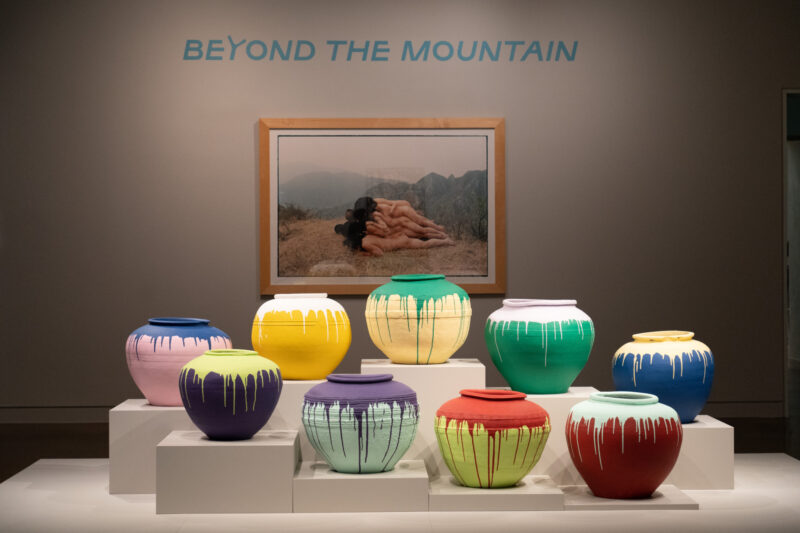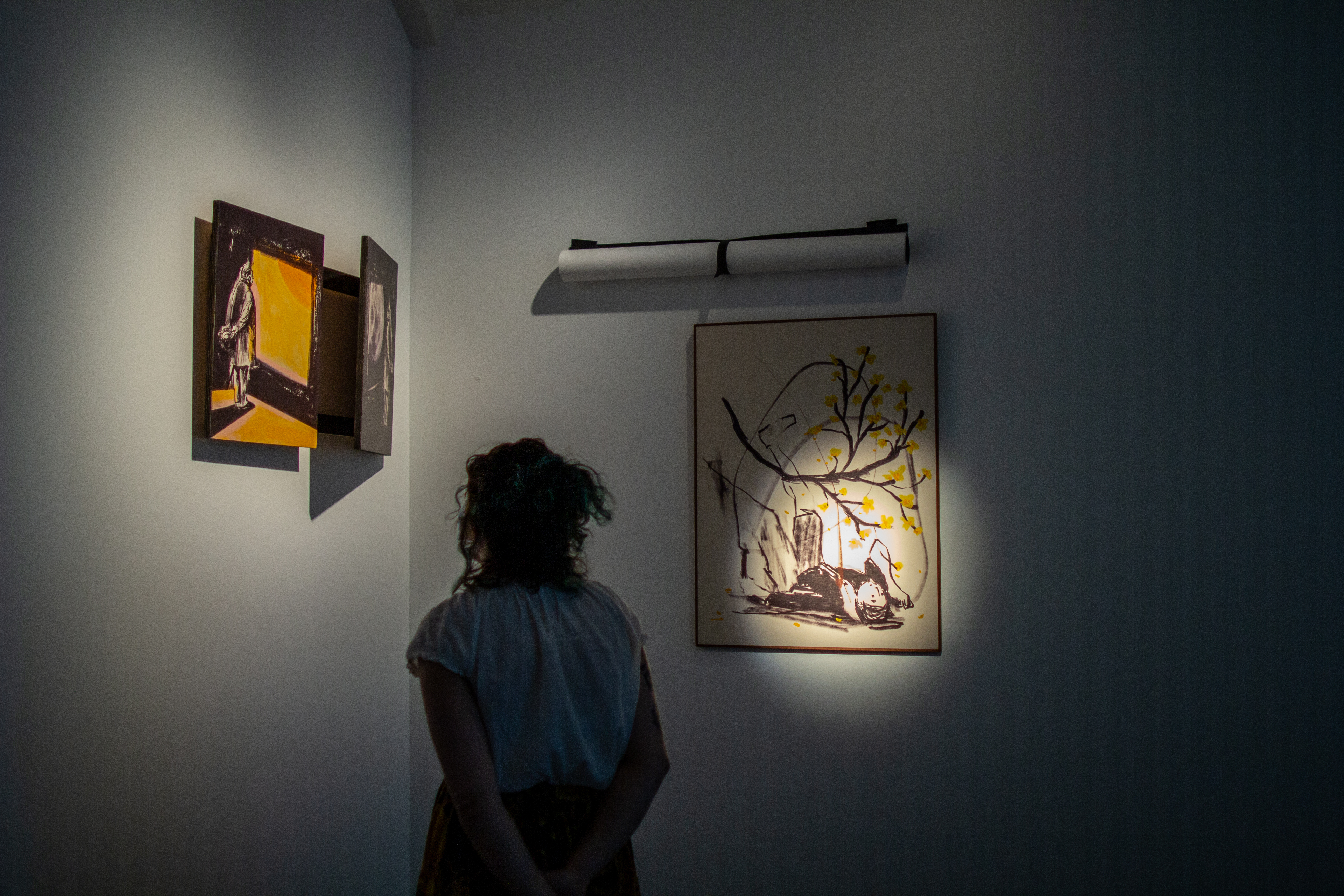Behind the Art of "Beyond the Mountain"
Review of Beyond the Mountain at the Seattle Asian Art Museum
Written by Teen Writer Olivia Qi and edited by Teen Editor Esha Potharaju

There’s a mountain of historical Chinese art, and many people are familiar with its loose inky style. But what lies beyond the mountain? The answers, present in the Seattle Asian Art Museum’s Beyond the Mountain exhibit, are thought-provoking performance art, painting, photography, and multimedia installations. The exhibit is organized around five themes and five artists. The themes are combinations of a traditional motif and concepts gaining traction in the modern world, with names like ink/protest, artifact/culture, proverb/nature, landscape/cityscape, and landscape/escape. Beyond the Mountain shows how contemporary Chinese artists react to a modern world while staying rooted in tradition. Furthermore, it shows how their Chinese art breaks national boundaries, becoming internationally relevant in the face of globalization.
ink/protest
The gallery greets the viewer with a description of itself on a teal wall. Jasiri X’s song “Occupy (We the 99)” spills out from behind the wall, inviting you to enter a dark room featuring Chen Shaoxiong’s Ink Media #4 (2011-2013)—a row of four ink wash paintings on rice paper and a video.
Though Chen himself wrote that he used ink paper, the exhibit’s curator, Ping Foong, notes that this is an inaccuracy.
“He knows this artwork is going to be shown in the West, so he describes the paper as rice paper,” Foong explains. “It’s an interesting concept because in China, you don’t call it rice paper. It’s a term which tries to express just how Chinese it is to a non-Chinese audience. It’s called Xuan paper, ‘rice’ indicating that it is white.”
The ink wash technique Chen uses dates back to China’s Tang Dynasty (618-908), aiming to reproduce a subject’s spirit while maintaining simplicity and spontaneity. It is most commonly used for painting landscapes, which were political during the Tang dynasty, with the mountain representing the Emperor and trees being the emperor’s complacent subjects.
While traditional ink landscapes emphasized the divine, natural order of power, Chen uses the political nature of ink landscape to paint modern protests against political and financial abuses of power. He highlights the chaos of cops breaking up a riot, the loud ambition of marching rebels, and the quiet courage of a single woman holding a protest sign by a street.
Chen globalizes the traditional ink wash technique by capturing the struggles of people against tyranny across the world in all of his paintings. But wait—among the paintings of Egyptians protesting the Mubarak regime, Americans marching in Wall Street, and Hongkongers demanding universal suffrage is a picture of a water-pistol fight during a Toronto gay pride parade. By placing an image about fun in the midst of paintings of government violence, Chen removes it from its original context and proves to the viewer how easy it is to misinterpret images. In today’s world where complicated issues are abbreviated into flashy news headlines, Chen emphasizes the need for critical eye.
The music choices add to the sense of a common, globalized struggle. Jasiri X is an American rapper who mainly raps about the Black American experience, yet his music is also relevant as a background track to paintings of other marginalized groups’ struggles. A Taiwanese version of “Do You Hear the People Sing” from Les Misérables plays after the Jasiri X song, and is a popular protest anthem internationally.
artifact/culture
Behind the dark ink/protest room is a bright space containing the artifact/culture and proverb/nature works. Internationally famous (and to some, infamous) artist and activist Ai Weiwei’s Colored Vases (2010) cleverly conveys the artifact/culture theme. There are nine colorful vases in the center of the room, each dipped in two vibrant shades of industrial paint. The vases are actually ancient artifacts, possibly dating from the Han Dynasty, causing many to consider Ai’s act of repainting them vandalism. But does Ai destroy culture or add to it? By coating the vases in industrial paint, Ai reflects an industrialized, modern China in his art.
Born in 1957, Ai is very influenced by China’s Cultural Revolution, which started in 1966. He witnessed firsthand the horrors of the Revolution, which sought to eliminate all traditional Chinese values and craftsmanship, and his Colored Vases (2010) is a small-scale allegory of that. Ai uses the anger at the destruction of cultural artifacts that Colored Vases elicits to shrewdly contextualize the atrocities of the Cultural Revolution.
In a rapidly modernizing world, it’s easy to forget about the past. Ai's Colored Vases demand the viewer to think about how we treat history—and not just Chinese history. As Foong states, “Ai Weiwei can certainly straddle the label of ‘Chinese artist,’ and that’s part of his ability to transcend national boundaries.”
proverb/nature
Ai’s vases lead the eyes to Zhang Huan’s photograph of bodies piled on a mountain, titled To Add One Meter to an Anonymous Mountain (1995). There’s an old Chinese proverb, “Beyond the mountain, there are higher mountains yet,” and Zhang uses this combined theme of proverb and nature to make a statement about humility. The bodies of his friends, fellow artists, are piled atop Mount Miaofengshan, appearing taller than the mountain peak. But after Zhang takes the photo and his friends climb off the mountain, they return to their original height, once again dwarfed by the grandeur of nature. Zhang’s photograph comments on the vain futility of people’s attempts to outdo nature, as seen in modern society, where scientists try to transcend evolution and businesses seek to develop every untouched square meter of land. On a lighter note, To Add One Meter to an Anonymous Mountain has become a meme in fine art circles.
When displaying this photo, most museums focus on the pile of bodies, but curator Ping Foong instead decided to emphasize the mountain.
“The photograph has the mountain in the background, and we decided the [Ai Weiwei] pots could connect with it visually, even though conceptually it kind of sucked. But we wanted to make a spatial-visual connection in the gallery itself,” Foong says. “So my designer and I collaborated, and he came up with this idea of making a hiking trail with the pots, going up to the mountain.”
By doing so, she adds a new perspective to the two well-known pieces of art.
landscape/cityscape
When I first walked into the small dark room housing the landscape/cityscape artworks, I mistook Yang Yongliang’s The Departure (2019; 8:30 minutes) and The Return (2019; 6:30 minutes) to be classical-style ink paintings. Similar to Song Dynasty ink landscapes, Yang’s works are huge—10 feet tall—and detail black-and-white depictions of a mountain and water. Upon closer inspection, I realized they were actually videos stitched together from thousands of photos and videos of Asian megacities. In The Departure and The Return, waterfalls tumble amongst buildings, cars, highways and construction nestled into the mountainside. Yang’s work calls into question: If ink landscapes used to be about the divine order between the emperor and the subjects, is the order between nature and urbanity divine?

landscape/escape
Lam Tung Pang’s works are housed in a room of their own, with The Great Escape (2020) in the center. It’s a huge six-sided lantern with painted landscape imagery and videos projected on its sides: a man illustrated with ink looks out of a window at a rotating moon and a street light flashes. Inside the lantern is a small rotating scale-model home, and its shadows project onto the lantern as well. The shadows and light occasionally escape through cracks of the lantern panels and into the room, extending the traditionally 2-D medium of shadow puppets to three dimensions.
The Great Escape reflects Lam’s personal experience of being trapped at home during the pandemic-induced quarantine, and he connects his isolation to that of ancient Chinese hermits retreating into nature.
The COVID-19 quarantine affected Foong’s curating process as well. It took five years to curate Beyond The Mountain. “To get [Lam’s] artwork over from Hong Kong to Seattle was a great challenge because earlier this year, there were no flights,” she says. “It was actually quite difficult to get the art, even after he had created the installation and packed it all up. We had to wait for it to get on a flight.”
One of Lam’s other works, When The Time Comes, is a paper packet with plastic wild animal figurines trailing out of it, all placed on a small shelf labeled “When The Time Comes.” This shows a more modern form of escapism, reminiscent of a child immersing themself in an imaginary world with their toys. Lam writes that his work is also influenced by Harry Houdini’s daring escapes and avant-garde Japanese filmmaker Shuji Terayama’s magic and illusion.
What does it mean for art to be Chinese?
Lam’s art has a wide range of international influences, similar to Chen’s Ink Media #4. Ai Weiwei is famous for his art well outside of China and his activism extends to international crises. Zhang’s To Add One Meter and Yang’s The Departure and The Return use mediums that modern artists everywhere around the world use. So, what makes their art Chinese, and what is their niche in the international art scene?
“Everybody is asking this question—artists, curators, academics, everybody—which is, what place does Chinese art have in the global stage?” Foong says. “Is it even correct to call it Chinese art at all? How is it that artists from the West possess the word ‘global artist’? Why are Chinese artists siloed as just Chinese? Besides, what do you mean by Chinese artist? Are they born in a certain place, say mainland China or one of the diasporas: Hong Kong, Taiwan, or Singapore? Then they move and then establish studios in Berlin, in London, in somewhere else. Are they still a Chinese artist? How about Asian Americans?”
In an increasingly globalized world, identities form complicated intersections. While all the artists featured in Beyond The Mountain use traditionally Chinese mediums and techniques, their art is about more than just China. It’s about globalization, an increasingly urban world, the respect for and erasure of the past, and how we interact with the struggles of modernity.
Beyond the Mountain took place at the Seattle Asian Art Museum on July 22, 2022 — Ongoing. For more information see here.
Lead Photo: Works by Ai Weiwei (vases) and Zhang Huan (photograph) in Beyond the Mountain at the Seattle Asian Art Museum. Photo by Chloe Collyer.
The TeenTix Newsroom is a group of teen writers led by the Teen Editorial Staff. For each review, Newsroom writers work individually with a teen editor to polish their writing for publication. The Teen Editorial Staff is made up of 6 teens who curate the review portion of the TeenTix blog. More information about the Teen Editorial Staff can be found HERE.
The TeenTix Press Corps promotes critical thinking, communication, and information literacy through criticism and journalism practice for teens. For more information about the Press Corps program see HERE.


